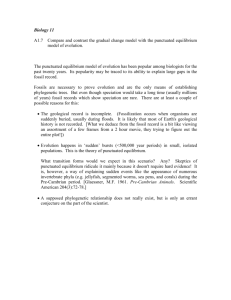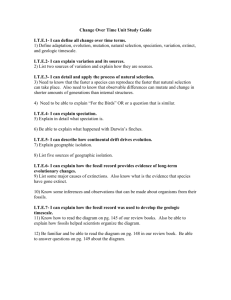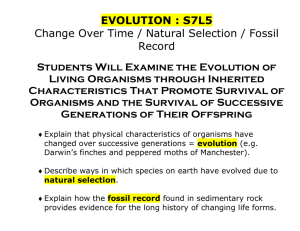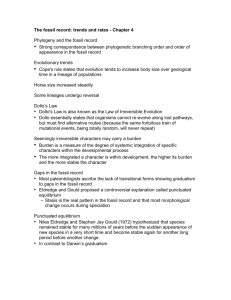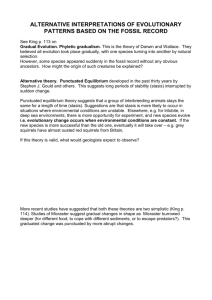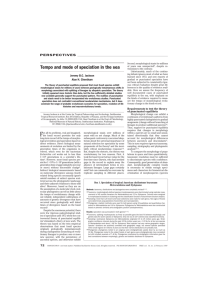Tempo and Mode of Speciation How fast does speciation happen
advertisement
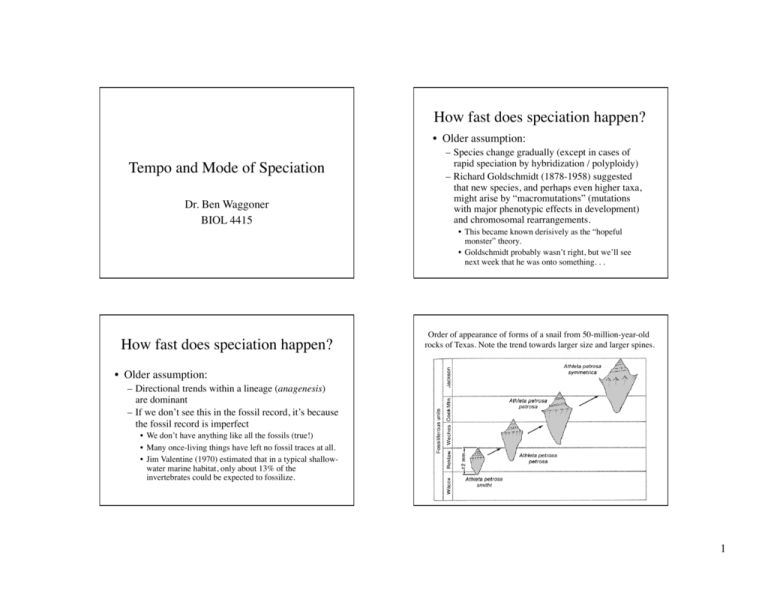
How fast does speciation happen? • Older assumption: Tempo and Mode of Speciation Dr. Ben Waggoner BIOL 4415 – Species change gradually (except in cases of rapid speciation by hybridization / polyploidy) – Richard Goldschmidt (1878-1958) suggested that new species, and perhaps even higher taxa, might arise by “macromutations” (mutations with major phenotypic effects in development) and chromosomal rearrangements. • This became known derisively as the “hopeful monster” theory. • Goldschmidt probably wasn’t right, but we’ll see next week that he was onto something. . . How fast does speciation happen? Order of appearance of forms of a snail from 50-million-year-old rocks of Texas. Note the trend towards larger size and larger spines. • Older assumption: – Directional trends within a lineage (anagenesis) are dominant – If we don’t see this in the fossil record, it’s because the fossil record is imperfect • We don’t have anything like all the fossils (true!) • Many once-living things have left no fossil traces at all. • Jim Valentine (1970) estimated that in a typical shallowwater marine habitat, only about 13% of the invertebrates could be expected to fossilize. 1 “Punk eek”??? Trend towards larger size over a period of about 15 million years in fossil populations (about 260-245 million years old) of a shelled protist, Lepidolina multiseptata. • Punctuated equilibrium is the name for the pattern of the timing of speciation observed in the fossil record – Proposed under that name by Stephen Jay Gould and Niles Eldredge in the 1970s – Contradicted the expected pattern of gradualistic appearance of species • New species appear abruptly • Species then stay the same for millions of years • Predominant evolutionary dynamic is cladogenesis (branching off of new lineages) • NOTE: “Punk eek” is not a causal theory of how species form (which the “hopeful monster” theory was); it’s a description of the pattern of species formation over time. Consider Hyopsodus, a 50-million-year-old mammal known as a condylarth. . . Gradualistic model Punctuated model Paleontologist Phil Gingerich measured molar tooth size for hundreds of Hyopsodus, collected in northwestern Wyoming. He graphed tooth size against position in the stratigraphic column. . . 2 . . . and here’s what he found. (Horizontal bars represent size ranges for samples of many teeth from one level.) A former fellow grad student of mine, by the name of Ross Nehm, has demonstrated another transition in a group of marine snails known as marginellids. Some other lineages can be traced in the fossil record, like this early North American primate Pelycodus. Pelycodus is divided into chronospecies— but where do you draw the lines? And the Y axis is not necessarily proportional to time. . . Nehm made a number of measurements on many fossil marginellid shells from Costa Rica, and combined the measurements into a single number per shell that expressed most of the variation in his samples (a technique called principal components analysis). A living marginellid species, Prunum carneum 3 And here’s what the variation over time looks like in a series of samples of fossils (graphed as a stack of histograms). At the bottom: a broad species called Prunum coniforme. At the top: a slender species called Prunum christineladdae. In between, a gradual transformation. Why Foraminifera? • Forams are extremely abundant in oceans • Pelagic (floating) forams die and constantly sink to the bottom, creating thick layers of “foram ooze” in some regions • Drilling samples of deep-sea sediments lets us trace evolutionary changes in very fine detail Foraminifera • Planktonic or benthic marine protists • Amoeba-like bodies • Secrete a test—a shell-like covering, typically calcareous (chalky) or agglutinated (made of small sediment grains glued together) • Test perforated with tiny holes, or foramina The transition from the foram species Globorotalia plesiotumida (bottom) to Globorotalia tumida (top) involved a “sudden”, but still continuous, increase in size between about 5.5 and 6.0 million years ago. (Graph shows size ranges and mean sizes of samples.) 4 Resolution? • From the point of view of a paleontologist, 10,000 100,000 years is a brief instant We do get populations that “track” environments by adaptation through natural selection, as you saw in Darwin’s finches, and as is shown here in several lineages of trilobites through time. But these rates don’t have to be steady—and don’t always lead to new species! – The transition from one species to the next is often so “fast” that it can’t be seen clearly in the fossil record • From the point of view of a worker on modern organisms, 10,000 - 100,000 years is unbelievably long – Whether a pattern looks “gradual” or “punctuated” may well depend on the observer’s choice of timescale Resolution? • Gould originally claimed that punctuated equilibrium meant that other forces than those of classical neo-Darwinism were needed to explain evolution at and above the species level – “Macroevolution is decoupled from microevolution” • This doesn’t seem as likely now – Large populations show little drift, slow selective response—they should change slowly, if at all! – Punctuated equilibrium fits with a peripatric mode of speciation Anagenesis is popularly thought of as the entirety of evolution—as in the infamous and much-parodied “March of Progress” drawing. . . 5 But cladogenesis has predominated in human evolution, as it has in the evolution of probably everything else. A more accurate picture of human evolution (though still subject to revision and expansion and debate) looks like this. Evolution Makes Trees. 6

